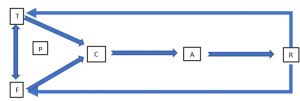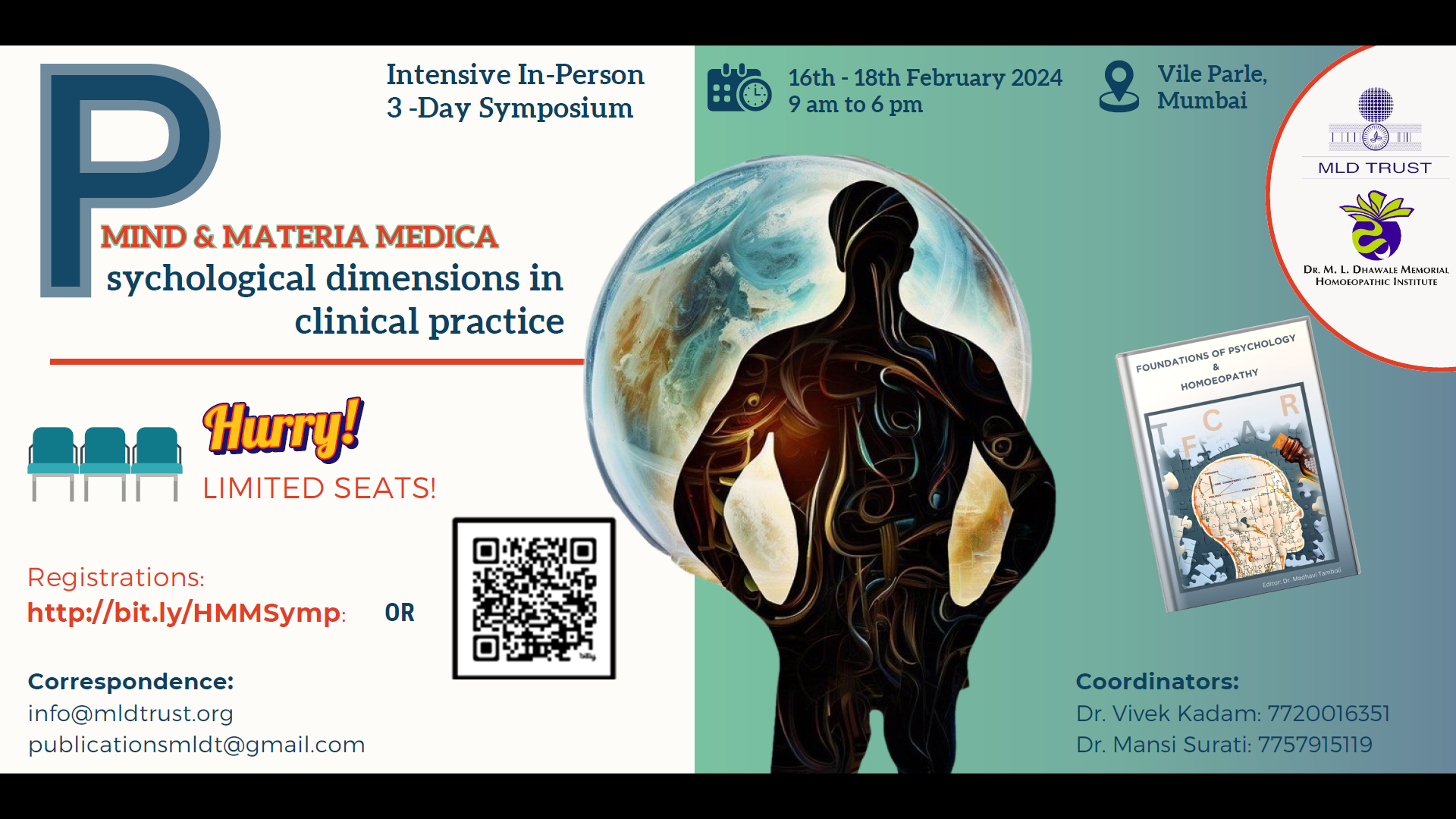Mind & Materia Medica:
Psychological Dimensions in Clinical Practice
Dates: 16 th – 18 th February 2024
VENUE: PTVA’s Institute of Management’s Keshavrao Ghaisas Hall, Navpada,Vile Parle
East, Mumbai 400057.
Introduction:
Mind is an important element in Homoeopathic prescribing and we do heavily rely on it for prescribing. Understanding the mind, however, is a challenge! Here we need to perceive the different components and their complex interplay in an objective manner.
The Homoeopathic Materia Medica is a record of provings and clinical observations. As Dr. Caroll Dunham mentions in his Lectures on Materia Medica, “The facts are the same to the eye of every reader. But where one mind may see only confusion and a maze of unconnected words, another may discern order and light and the outline of a definite consecutive chain of pathological processes, and consequently, a clear indication for the use of the drugs in the treatment of the sick.” This seems even more applicable to the study of the mental symptoms. Dr. Carol Dunham further states “While the Materia Medica in the books is a simple record of observed facts, in the mind of the practitioners it becomes the subject of reflection, of comparison, and of hypothetical reasoning, which will be more or less just and valuable according to the measure of the practitioner’s natural ability and of his intellectual culture”. Though not specifically defined here, perceiving the mind does need a rare capacity to receive the patient at several levels, a combination of analytical and synthetic faculties as well as the faculty of gestalt perception, i.e. the ability to connect the various symptoms to perceive a whole. How do we evolve these capacities in ourselves and our students?
While studying the Homoeopathic Materia Medica, we conceptualize facts in various ways and apply these to our patients, evolving various models. Dr. Kent expressed his understanding of the mind on the basis of Swedenborgian philosophy – the concepts of will, understanding and emotions. Utilizing these concepts, he built personality profiles of many polychrest remedies. Various stalwarts after Kent have attempted to understand the mind from different psychological perspectives, using different conceptions, and evolving remedial portraits. Boger lent a different dimension to the understanding of the mind through the incorporation of the time dimension and keen analytical and synthetic approach with abstraction. Notable among others are Drs. Whitmont, M. L. Dhawale, Catherine Coulter, George Vithoulkas, and Philip Bailey. One can understand the perspective of these authors only by diving deep into the concepts they have utilized while erecting their portraits.
Do we as ‘common’ homoeopaths possess the required knowledge and skills to delve into these concepts or practice on them? Admittedly, it may be difficult. But we need to begin somewhere. Where do we begin?
MLD sir has evolved tools to analyze the mind namely the Life space table and the Mental State SCR. NLT sir laid down the foundations for the study of patients through his delineation of Unprejudiced Observation and Drs. Manoj Patel and Madhavi Tamboli extended these concepts to the study of the Mind.
Dr. M.L. Dhawale also evolved the T-F-C-A-R Model, a fundamental tool to decode intricacies of the multifaceted mental functions and a distillate of Dr. M. L. Dhawale’s clinical observations and thinking.
What is this model? T (Thoughts) and Feelings (F) are vectors (Forces with direction) in the mind. They exert a pull on our mind. When they pull together in one direction, they allow a person to be committed (C), action (A) is performed well, leading to good results (R). When these forces are not aligned, the commitment wavers, the action is weak, and the results are not happy. Feedback can be educative and we can choose to take the right action. We can represent it thus, diagrammatically:

This basic thought, a distillate of Dr. M. L. Dhawale’s clinical observations and thinking, is borne out again and again in clinical practice. We have found it to be a central model representing Life itself! Homoeopathy has the potential to influence the vectors of T and F to bring them into a greater alignment with the larger purpose.
The symposium will explore and incorporate the knowledge of basic psychological principles, delve into the different dimensions of the mind and their interplay, and try to map these dimensions onto the minds in different remedies. This will be done through through a directed study of the mind through well-defined cases, based on the concepts outlined in the ‘Foundations of Psychology and Homoeopathy’ our newly released book. We will evolve a comprehensive mental picture based on the T-F-C-A-R model which can aid better Materia Medica differentiation and its application at the bedside.
Objectives:
- Studying man and understanding the Homoeopathic Materia Medica through the T-F-C-A-R model
- Re-visiting the different components of the mind and their inter-relationships in the clinical context
- Understanding the balance (imbalance) struck by the patient through actions released from time to time.
- Perceiving the thoughts, feelings, motivations, drives and purpose behind various actions released and deriving the attributes as well as disposition
- Perceiving the same in remedies through the study of source books and matching it with that of the patient.
- Comparing and contrasting these patterns in different drugs.
- Integrating data from the patient and the HMM to evolve comprehensive Living Materia Medica images of remedies.
Methodology: Well documented cases will be taken for discussion with the following features:
- Case with written history
- Detailed life space with minimum gaps
- Complete SCR data
- Undisputed results.
The focus will be the study and application of the T-F-C-A-R model making this symposium the first formal in-depth study of cases and of HMM using the T-F-C-A-R model.
Who should attend:
The symposium will benefit teachers, practitioners, Postgraduates and interns as well as undergraduate students as they will understand and will be able to use a valuable tool to understand the mind of the patient and of the remedies in the Homoeopathic Materia Medica. It will be of special interest to the teachers of Organon, Materia Medica and Psychiatry as they would be able to use it in their regular academic and research work.
Dates: 16th – 18th February 2024
Venue: PTVA’s Institute of Management’s Keshavrao Ghaisas Hall, Navpada,Vile Parle East, Mumbai 400057
G-map location: https://maps.app.goo.gl/7FJgVWkamAGmoECt8
Registration Link: https://bit.ly/HMMSymp
Donation:
On or before 31st January
Teachers/Practitioners : 4500/-
Students/Interns : 3500/-
After 31st January
Teachers/Practitioners : 5000/-
Students/Interns : 4000/-
Payment to Dr. M. L. Dhawale Memorial Trust
Bank name: The Saraswat Co-op Bank Ltd
A/c No: 059100100001807
IFSC code: SRCB0000059
QR code:

Faculty:
Director: Dr. Bhavik Parekh, Director, PG Education
Coordinators: Dr. Vivek Kadam, Associate Prof, HMM, MLDMHI and Dr. Mansi Surati, Asstt Professor, Psychiatry, MLDMHI

